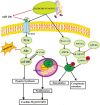Potential Role of Exercise in Regulating YAP and TAZ During Cardiomyocytes Aging
- PMID: 35379136
- PMCID: PMC9896415
- DOI: 10.2174/1573403X18666220404152924
Potential Role of Exercise in Regulating YAP and TAZ During Cardiomyocytes Aging
Abstract
Adaptation of cardiac muscle to regular exercise results in morphological and structural changes known as physiological cardiac hypertrophy, to which the Hippo signaling pathway might have contributed. Two major terminal effectors in the Hippo signaling pathway are Yes-associated protein (YAP) and its homolog transcriptional coactivator with PDZ-binding motif (TAZ). The latest studies have reported the role of YAP and TAZ in different life stages, such as in fetal, neonatal, and adult hearts. Their regulation might involve several mechanisms and effectors. One of the possible coregulators is exercise. Exercise plays a role in cardiomyocyte hypertrophic changes during different stages of life, including in aged hearts. YAP/TAZ signaling pathway has a role in physiological cardiac hypertrophy induced by exercise and is associated with cardiac remodelling. Thus, it can be believed that exercise has roles in activating the signaling pathway of YAP and TAZ in aged cardiomyocytes. However, the studies regarding the roles of YAP and TAZ during cardiomyocyte aging are limited. The primary purpose of this review is to explore the response of cardiovascular aging to exercise via signaling pathway of YAP and TAZ.
Keywords: Aging; TAZ; YAP; cardiac hypertrophy; cardiomyocyte; exercise.
Copyright© Bentham Science Publishers; For any queries, please email at epub@benthamscience.net.
Figures
References
Publication types
MeSH terms
Substances
Grants and funding
LinkOut - more resources
Full Text Sources



